Ethical Management Leadership: Challenges and Solutions in Asia
VerifiedAdded on 2021/05/31
|10
|2993
|165
Essay
AI Summary
This essay delves into the critical aspects of ethical management leadership within the context of Asian businesses, highlighting the challenges faced by managers in implementing ethical practices. It underscores the importance of ethical leadership in fostering corporate social responsibility, brand reputation, and compliance with laws, while also addressing issues like environmental pollution and consumer protection. The essay analyzes specific challenges such as lack of teamwork, poor communication, cultural diversity, and the high costs associated with ethical standards. It uses examples of companies like KOSAN, Toyota, and Carlsberg to illustrate these challenges, particularly focusing on issues like employee training, inconsistency in ethical guidelines, and the pressure to prioritize profits over ethical considerations. The essay concludes with recommendations for managers in Asian countries, emphasizing the need for well-documented ethical policies, improved communication channels, and a balanced approach to profit and ethical responsibility.
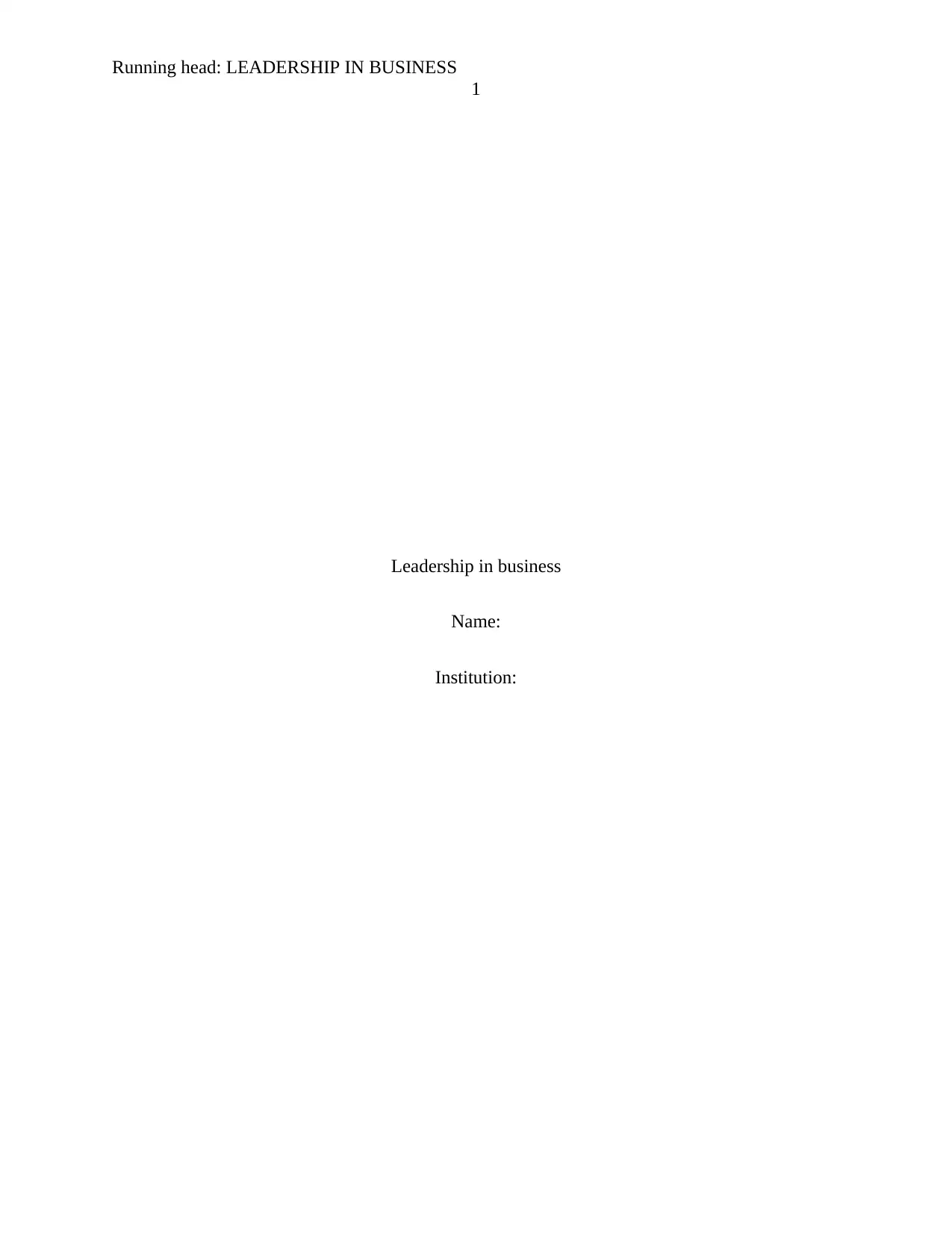
Running head: LEADERSHIP IN BUSINESS
1
Leadership in business
Name:
Institution:
1
Leadership in business
Name:
Institution:
Paraphrase This Document
Need a fresh take? Get an instant paraphrase of this document with our AI Paraphraser
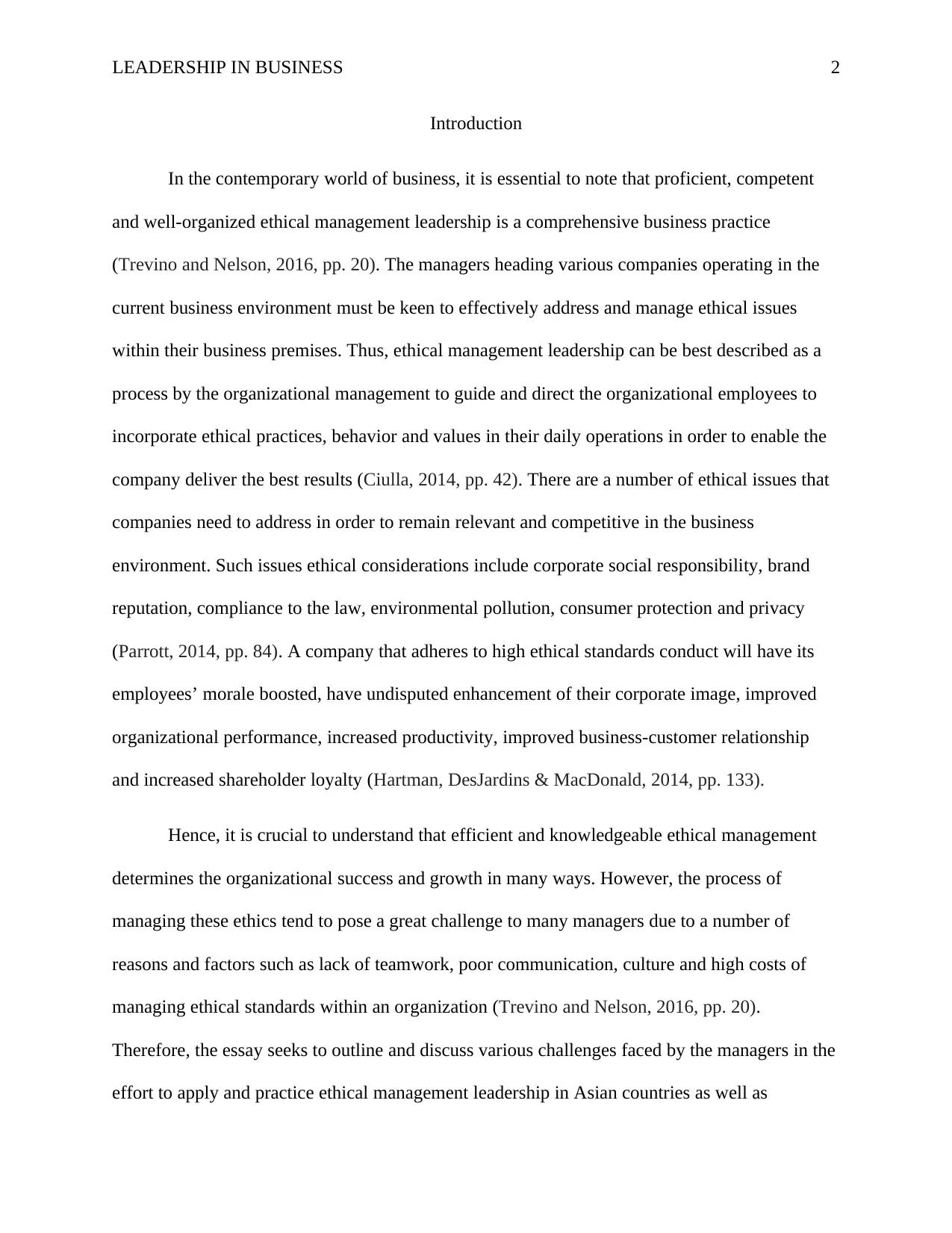
LEADERSHIP IN BUSINESS 2
Introduction
In the contemporary world of business, it is essential to note that proficient, competent
and well-organized ethical management leadership is a comprehensive business practice
(Trevino and Nelson, 2016, pp. 20). The managers heading various companies operating in the
current business environment must be keen to effectively address and manage ethical issues
within their business premises. Thus, ethical management leadership can be best described as a
process by the organizational management to guide and direct the organizational employees to
incorporate ethical practices, behavior and values in their daily operations in order to enable the
company deliver the best results (Ciulla, 2014, pp. 42). There are a number of ethical issues that
companies need to address in order to remain relevant and competitive in the business
environment. Such issues ethical considerations include corporate social responsibility, brand
reputation, compliance to the law, environmental pollution, consumer protection and privacy
(Parrott, 2014, pp. 84). A company that adheres to high ethical standards conduct will have its
employees’ morale boosted, have undisputed enhancement of their corporate image, improved
organizational performance, increased productivity, improved business-customer relationship
and increased shareholder loyalty (Hartman, DesJardins & MacDonald, 2014, pp. 133).
Hence, it is crucial to understand that efficient and knowledgeable ethical management
determines the organizational success and growth in many ways. However, the process of
managing these ethics tend to pose a great challenge to many managers due to a number of
reasons and factors such as lack of teamwork, poor communication, culture and high costs of
managing ethical standards within an organization (Trevino and Nelson, 2016, pp. 20).
Therefore, the essay seeks to outline and discuss various challenges faced by the managers in the
effort to apply and practice ethical management leadership in Asian countries as well as
Introduction
In the contemporary world of business, it is essential to note that proficient, competent
and well-organized ethical management leadership is a comprehensive business practice
(Trevino and Nelson, 2016, pp. 20). The managers heading various companies operating in the
current business environment must be keen to effectively address and manage ethical issues
within their business premises. Thus, ethical management leadership can be best described as a
process by the organizational management to guide and direct the organizational employees to
incorporate ethical practices, behavior and values in their daily operations in order to enable the
company deliver the best results (Ciulla, 2014, pp. 42). There are a number of ethical issues that
companies need to address in order to remain relevant and competitive in the business
environment. Such issues ethical considerations include corporate social responsibility, brand
reputation, compliance to the law, environmental pollution, consumer protection and privacy
(Parrott, 2014, pp. 84). A company that adheres to high ethical standards conduct will have its
employees’ morale boosted, have undisputed enhancement of their corporate image, improved
organizational performance, increased productivity, improved business-customer relationship
and increased shareholder loyalty (Hartman, DesJardins & MacDonald, 2014, pp. 133).
Hence, it is crucial to understand that efficient and knowledgeable ethical management
determines the organizational success and growth in many ways. However, the process of
managing these ethics tend to pose a great challenge to many managers due to a number of
reasons and factors such as lack of teamwork, poor communication, culture and high costs of
managing ethical standards within an organization (Trevino and Nelson, 2016, pp. 20).
Therefore, the essay seeks to outline and discuss various challenges faced by the managers in the
effort to apply and practice ethical management leadership in Asian countries as well as
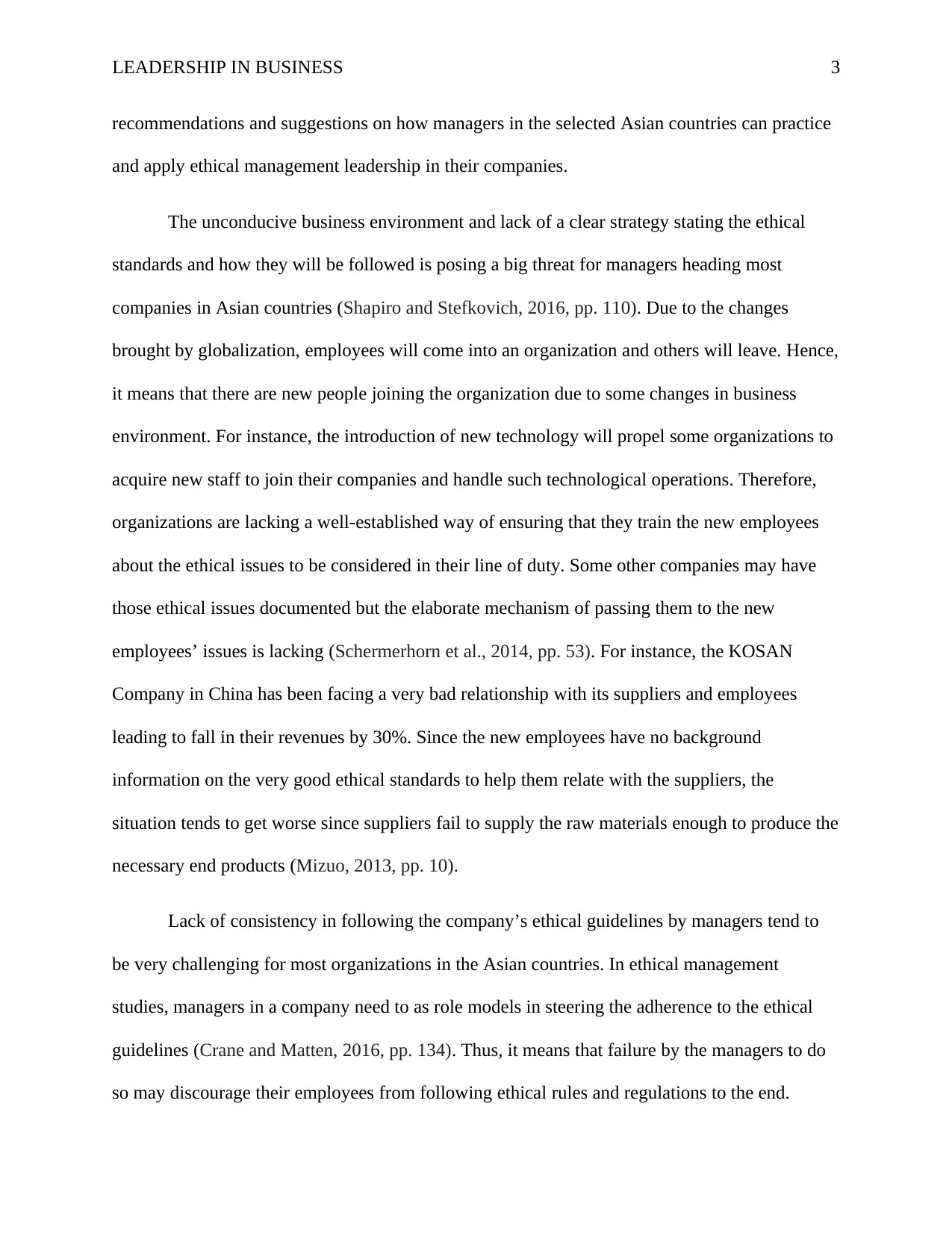
LEADERSHIP IN BUSINESS 3
recommendations and suggestions on how managers in the selected Asian countries can practice
and apply ethical management leadership in their companies.
The unconducive business environment and lack of a clear strategy stating the ethical
standards and how they will be followed is posing a big threat for managers heading most
companies in Asian countries (Shapiro and Stefkovich, 2016, pp. 110). Due to the changes
brought by globalization, employees will come into an organization and others will leave. Hence,
it means that there are new people joining the organization due to some changes in business
environment. For instance, the introduction of new technology will propel some organizations to
acquire new staff to join their companies and handle such technological operations. Therefore,
organizations are lacking a well-established way of ensuring that they train the new employees
about the ethical issues to be considered in their line of duty. Some other companies may have
those ethical issues documented but the elaborate mechanism of passing them to the new
employees’ issues is lacking (Schermerhorn et al., 2014, pp. 53). For instance, the KOSAN
Company in China has been facing a very bad relationship with its suppliers and employees
leading to fall in their revenues by 30%. Since the new employees have no background
information on the very good ethical standards to help them relate with the suppliers, the
situation tends to get worse since suppliers fail to supply the raw materials enough to produce the
necessary end products (Mizuo, 2013, pp. 10).
Lack of consistency in following the company’s ethical guidelines by managers tend to
be very challenging for most organizations in the Asian countries. In ethical management
studies, managers in a company need to as role models in steering the adherence to the ethical
guidelines (Crane and Matten, 2016, pp. 134). Thus, it means that failure by the managers to do
so may discourage their employees from following ethical rules and regulations to the end.
recommendations and suggestions on how managers in the selected Asian countries can practice
and apply ethical management leadership in their companies.
The unconducive business environment and lack of a clear strategy stating the ethical
standards and how they will be followed is posing a big threat for managers heading most
companies in Asian countries (Shapiro and Stefkovich, 2016, pp. 110). Due to the changes
brought by globalization, employees will come into an organization and others will leave. Hence,
it means that there are new people joining the organization due to some changes in business
environment. For instance, the introduction of new technology will propel some organizations to
acquire new staff to join their companies and handle such technological operations. Therefore,
organizations are lacking a well-established way of ensuring that they train the new employees
about the ethical issues to be considered in their line of duty. Some other companies may have
those ethical issues documented but the elaborate mechanism of passing them to the new
employees’ issues is lacking (Schermerhorn et al., 2014, pp. 53). For instance, the KOSAN
Company in China has been facing a very bad relationship with its suppliers and employees
leading to fall in their revenues by 30%. Since the new employees have no background
information on the very good ethical standards to help them relate with the suppliers, the
situation tends to get worse since suppliers fail to supply the raw materials enough to produce the
necessary end products (Mizuo, 2013, pp. 10).
Lack of consistency in following the company’s ethical guidelines by managers tend to
be very challenging for most organizations in the Asian countries. In ethical management
studies, managers in a company need to as role models in steering the adherence to the ethical
guidelines (Crane and Matten, 2016, pp. 134). Thus, it means that failure by the managers to do
so may discourage their employees from following ethical rules and regulations to the end.
⊘ This is a preview!⊘
Do you want full access?
Subscribe today to unlock all pages.

Trusted by 1+ million students worldwide
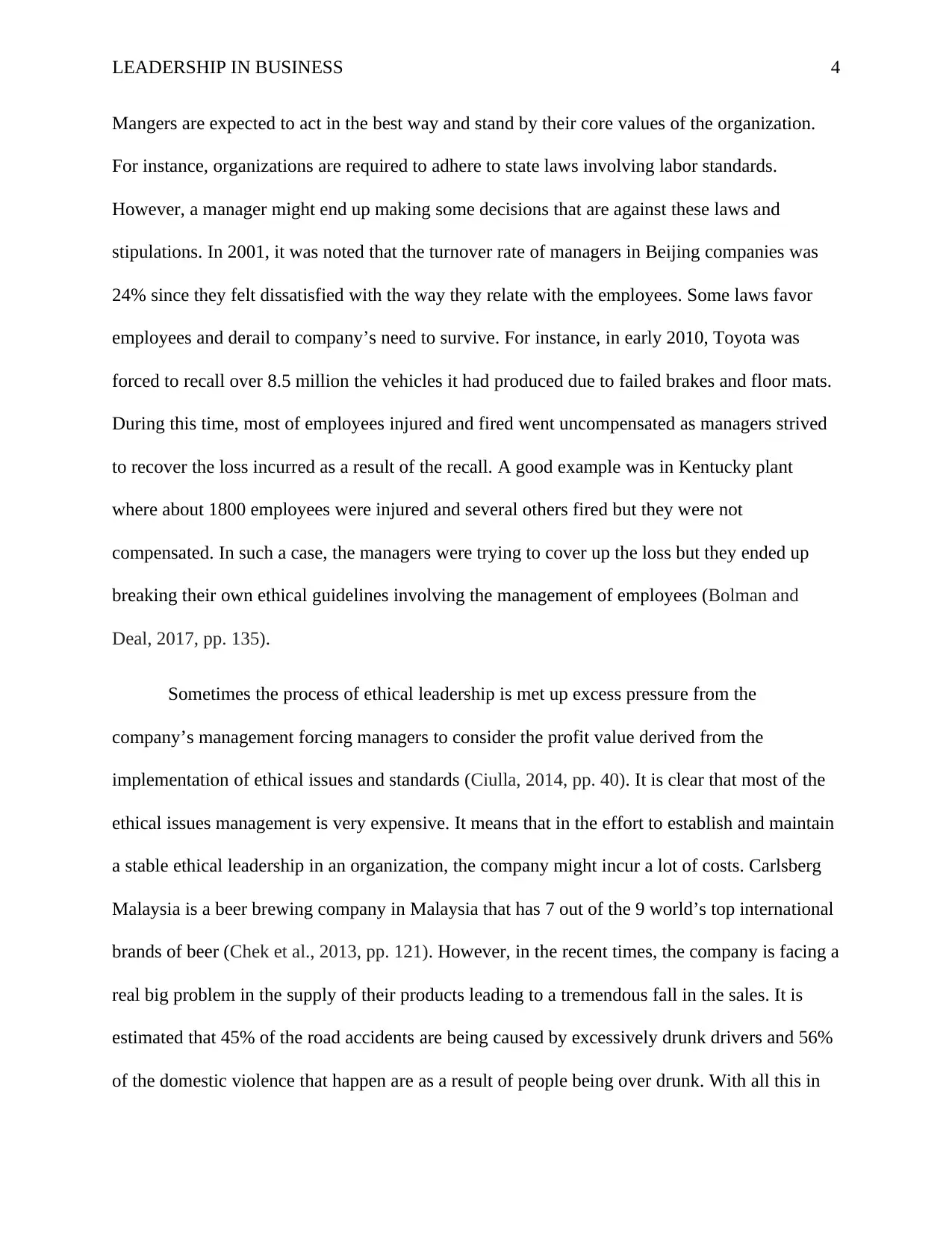
LEADERSHIP IN BUSINESS 4
Mangers are expected to act in the best way and stand by their core values of the organization.
For instance, organizations are required to adhere to state laws involving labor standards.
However, a manager might end up making some decisions that are against these laws and
stipulations. In 2001, it was noted that the turnover rate of managers in Beijing companies was
24% since they felt dissatisfied with the way they relate with the employees. Some laws favor
employees and derail to company’s need to survive. For instance, in early 2010, Toyota was
forced to recall over 8.5 million the vehicles it had produced due to failed brakes and floor mats.
During this time, most of employees injured and fired went uncompensated as managers strived
to recover the loss incurred as a result of the recall. A good example was in Kentucky plant
where about 1800 employees were injured and several others fired but they were not
compensated. In such a case, the managers were trying to cover up the loss but they ended up
breaking their own ethical guidelines involving the management of employees (Bolman and
Deal, 2017, pp. 135).
Sometimes the process of ethical leadership is met up excess pressure from the
company’s management forcing managers to consider the profit value derived from the
implementation of ethical issues and standards (Ciulla, 2014, pp. 40). It is clear that most of the
ethical issues management is very expensive. It means that in the effort to establish and maintain
a stable ethical leadership in an organization, the company might incur a lot of costs. Carlsberg
Malaysia is a beer brewing company in Malaysia that has 7 out of the 9 world’s top international
brands of beer (Chek et al., 2013, pp. 121). However, in the recent times, the company is facing a
real big problem in the supply of their products leading to a tremendous fall in the sales. It is
estimated that 45% of the road accidents are being caused by excessively drunk drivers and 56%
of the domestic violence that happen are as a result of people being over drunk. With all this in
Mangers are expected to act in the best way and stand by their core values of the organization.
For instance, organizations are required to adhere to state laws involving labor standards.
However, a manager might end up making some decisions that are against these laws and
stipulations. In 2001, it was noted that the turnover rate of managers in Beijing companies was
24% since they felt dissatisfied with the way they relate with the employees. Some laws favor
employees and derail to company’s need to survive. For instance, in early 2010, Toyota was
forced to recall over 8.5 million the vehicles it had produced due to failed brakes and floor mats.
During this time, most of employees injured and fired went uncompensated as managers strived
to recover the loss incurred as a result of the recall. A good example was in Kentucky plant
where about 1800 employees were injured and several others fired but they were not
compensated. In such a case, the managers were trying to cover up the loss but they ended up
breaking their own ethical guidelines involving the management of employees (Bolman and
Deal, 2017, pp. 135).
Sometimes the process of ethical leadership is met up excess pressure from the
company’s management forcing managers to consider the profit value derived from the
implementation of ethical issues and standards (Ciulla, 2014, pp. 40). It is clear that most of the
ethical issues management is very expensive. It means that in the effort to establish and maintain
a stable ethical leadership in an organization, the company might incur a lot of costs. Carlsberg
Malaysia is a beer brewing company in Malaysia that has 7 out of the 9 world’s top international
brands of beer (Chek et al., 2013, pp. 121). However, in the recent times, the company is facing a
real big problem in the supply of their products leading to a tremendous fall in the sales. It is
estimated that 45% of the road accidents are being caused by excessively drunk drivers and 56%
of the domestic violence that happen are as a result of people being over drunk. With all this in
Paraphrase This Document
Need a fresh take? Get an instant paraphrase of this document with our AI Paraphraser
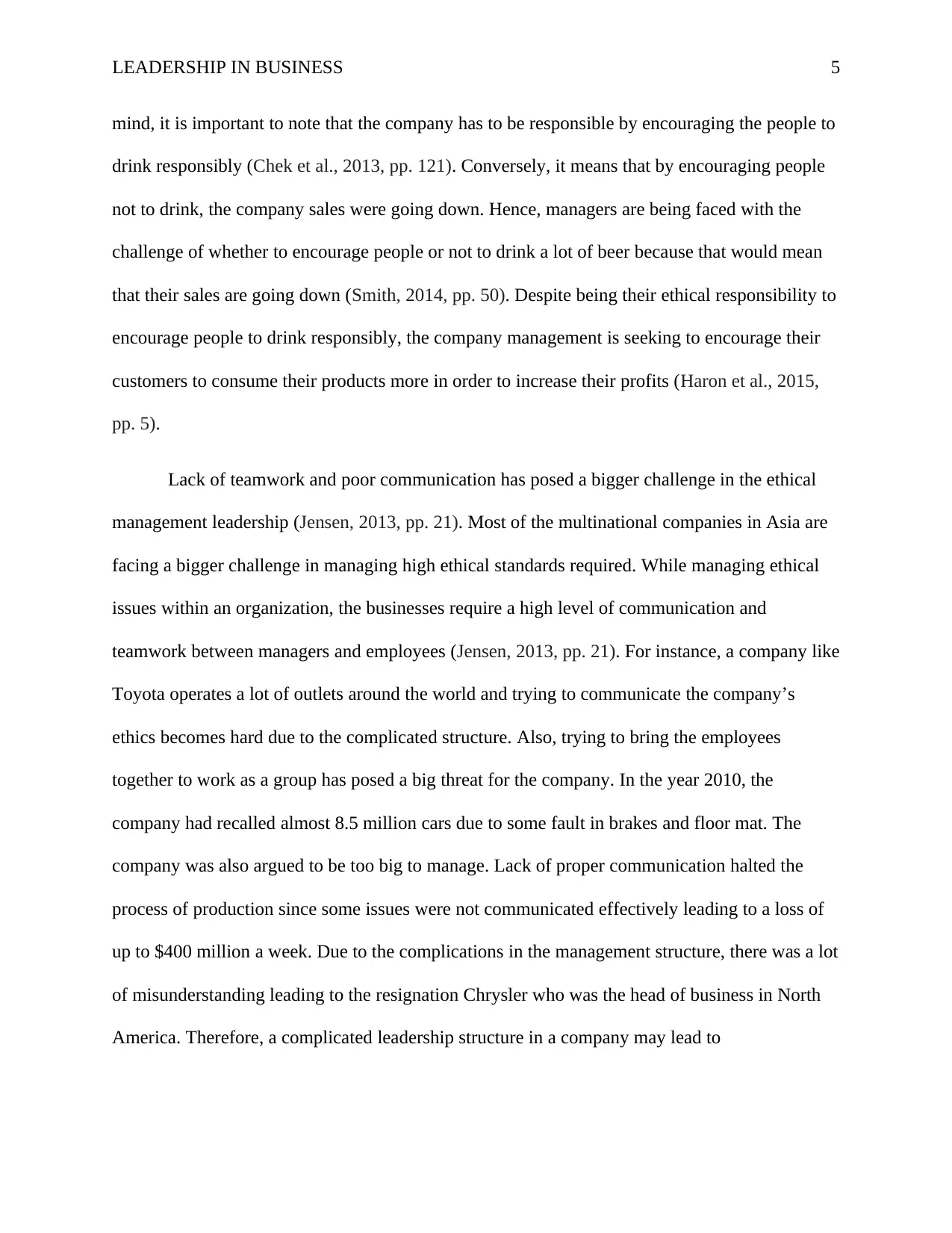
LEADERSHIP IN BUSINESS 5
mind, it is important to note that the company has to be responsible by encouraging the people to
drink responsibly (Chek et al., 2013, pp. 121). Conversely, it means that by encouraging people
not to drink, the company sales were going down. Hence, managers are being faced with the
challenge of whether to encourage people or not to drink a lot of beer because that would mean
that their sales are going down (Smith, 2014, pp. 50). Despite being their ethical responsibility to
encourage people to drink responsibly, the company management is seeking to encourage their
customers to consume their products more in order to increase their profits (Haron et al., 2015,
pp. 5).
Lack of teamwork and poor communication has posed a bigger challenge in the ethical
management leadership (Jensen, 2013, pp. 21). Most of the multinational companies in Asia are
facing a bigger challenge in managing high ethical standards required. While managing ethical
issues within an organization, the businesses require a high level of communication and
teamwork between managers and employees (Jensen, 2013, pp. 21). For instance, a company like
Toyota operates a lot of outlets around the world and trying to communicate the company’s
ethics becomes hard due to the complicated structure. Also, trying to bring the employees
together to work as a group has posed a big threat for the company. In the year 2010, the
company had recalled almost 8.5 million cars due to some fault in brakes and floor mat. The
company was also argued to be too big to manage. Lack of proper communication halted the
process of production since some issues were not communicated effectively leading to a loss of
up to $400 million a week. Due to the complications in the management structure, there was a lot
of misunderstanding leading to the resignation Chrysler who was the head of business in North
America. Therefore, a complicated leadership structure in a company may lead to
mind, it is important to note that the company has to be responsible by encouraging the people to
drink responsibly (Chek et al., 2013, pp. 121). Conversely, it means that by encouraging people
not to drink, the company sales were going down. Hence, managers are being faced with the
challenge of whether to encourage people or not to drink a lot of beer because that would mean
that their sales are going down (Smith, 2014, pp. 50). Despite being their ethical responsibility to
encourage people to drink responsibly, the company management is seeking to encourage their
customers to consume their products more in order to increase their profits (Haron et al., 2015,
pp. 5).
Lack of teamwork and poor communication has posed a bigger challenge in the ethical
management leadership (Jensen, 2013, pp. 21). Most of the multinational companies in Asia are
facing a bigger challenge in managing high ethical standards required. While managing ethical
issues within an organization, the businesses require a high level of communication and
teamwork between managers and employees (Jensen, 2013, pp. 21). For instance, a company like
Toyota operates a lot of outlets around the world and trying to communicate the company’s
ethics becomes hard due to the complicated structure. Also, trying to bring the employees
together to work as a group has posed a big threat for the company. In the year 2010, the
company had recalled almost 8.5 million cars due to some fault in brakes and floor mat. The
company was also argued to be too big to manage. Lack of proper communication halted the
process of production since some issues were not communicated effectively leading to a loss of
up to $400 million a week. Due to the complications in the management structure, there was a lot
of misunderstanding leading to the resignation Chrysler who was the head of business in North
America. Therefore, a complicated leadership structure in a company may lead to
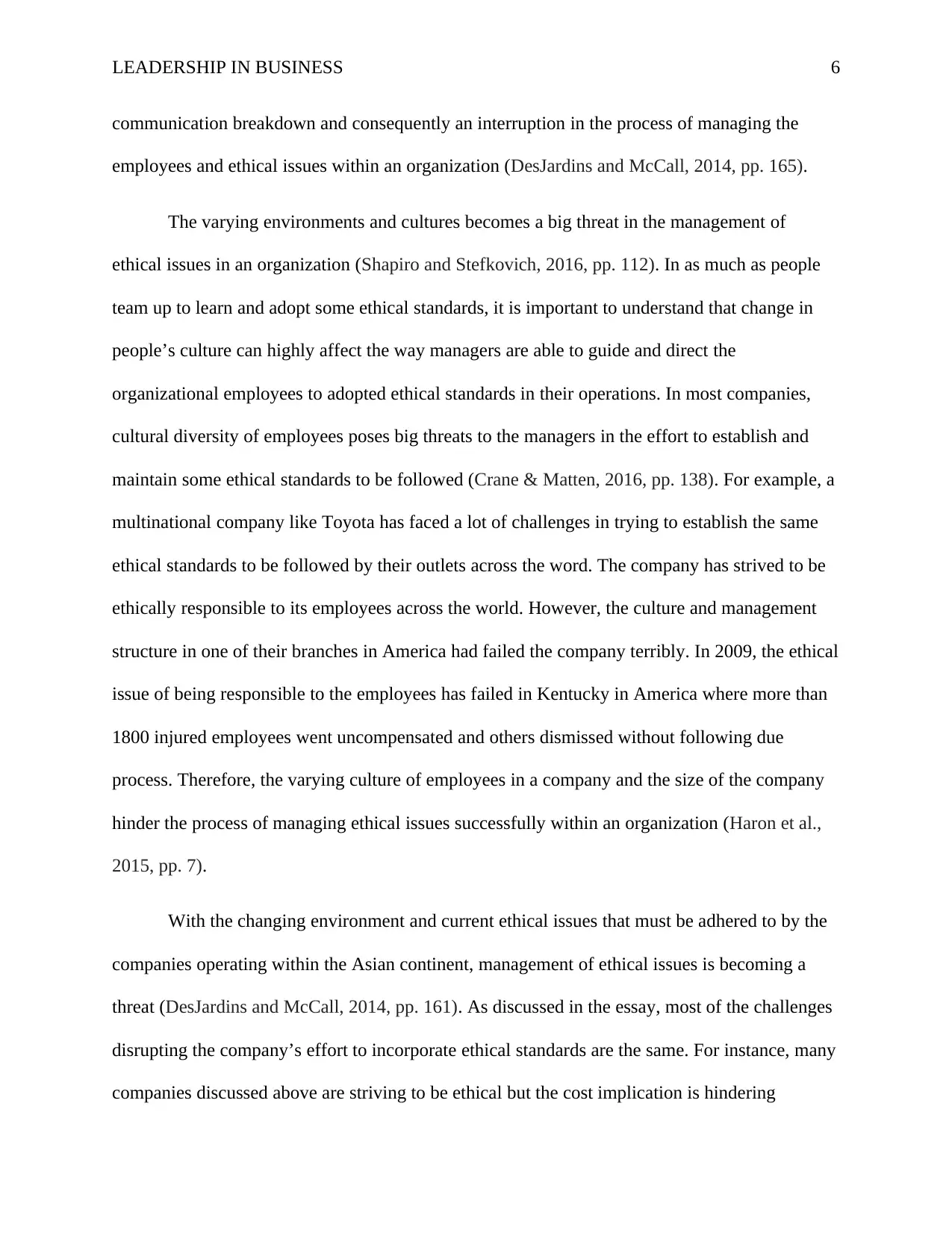
LEADERSHIP IN BUSINESS 6
communication breakdown and consequently an interruption in the process of managing the
employees and ethical issues within an organization (DesJardins and McCall, 2014, pp. 165).
The varying environments and cultures becomes a big threat in the management of
ethical issues in an organization (Shapiro and Stefkovich, 2016, pp. 112). In as much as people
team up to learn and adopt some ethical standards, it is important to understand that change in
people’s culture can highly affect the way managers are able to guide and direct the
organizational employees to adopted ethical standards in their operations. In most companies,
cultural diversity of employees poses big threats to the managers in the effort to establish and
maintain some ethical standards to be followed (Crane & Matten, 2016, pp. 138). For example, a
multinational company like Toyota has faced a lot of challenges in trying to establish the same
ethical standards to be followed by their outlets across the word. The company has strived to be
ethically responsible to its employees across the world. However, the culture and management
structure in one of their branches in America had failed the company terribly. In 2009, the ethical
issue of being responsible to the employees has failed in Kentucky in America where more than
1800 injured employees went uncompensated and others dismissed without following due
process. Therefore, the varying culture of employees in a company and the size of the company
hinder the process of managing ethical issues successfully within an organization (Haron et al.,
2015, pp. 7).
With the changing environment and current ethical issues that must be adhered to by the
companies operating within the Asian continent, management of ethical issues is becoming a
threat (DesJardins and McCall, 2014, pp. 161). As discussed in the essay, most of the challenges
disrupting the company’s effort to incorporate ethical standards are the same. For instance, many
companies discussed above are striving to be ethical but the cost implication is hindering
communication breakdown and consequently an interruption in the process of managing the
employees and ethical issues within an organization (DesJardins and McCall, 2014, pp. 165).
The varying environments and cultures becomes a big threat in the management of
ethical issues in an organization (Shapiro and Stefkovich, 2016, pp. 112). In as much as people
team up to learn and adopt some ethical standards, it is important to understand that change in
people’s culture can highly affect the way managers are able to guide and direct the
organizational employees to adopted ethical standards in their operations. In most companies,
cultural diversity of employees poses big threats to the managers in the effort to establish and
maintain some ethical standards to be followed (Crane & Matten, 2016, pp. 138). For example, a
multinational company like Toyota has faced a lot of challenges in trying to establish the same
ethical standards to be followed by their outlets across the word. The company has strived to be
ethically responsible to its employees across the world. However, the culture and management
structure in one of their branches in America had failed the company terribly. In 2009, the ethical
issue of being responsible to the employees has failed in Kentucky in America where more than
1800 injured employees went uncompensated and others dismissed without following due
process. Therefore, the varying culture of employees in a company and the size of the company
hinder the process of managing ethical issues successfully within an organization (Haron et al.,
2015, pp. 7).
With the changing environment and current ethical issues that must be adhered to by the
companies operating within the Asian continent, management of ethical issues is becoming a
threat (DesJardins and McCall, 2014, pp. 161). As discussed in the essay, most of the challenges
disrupting the company’s effort to incorporate ethical standards are the same. For instance, many
companies discussed above are striving to be ethical but the cost implication is hindering
⊘ This is a preview!⊘
Do you want full access?
Subscribe today to unlock all pages.

Trusted by 1+ million students worldwide
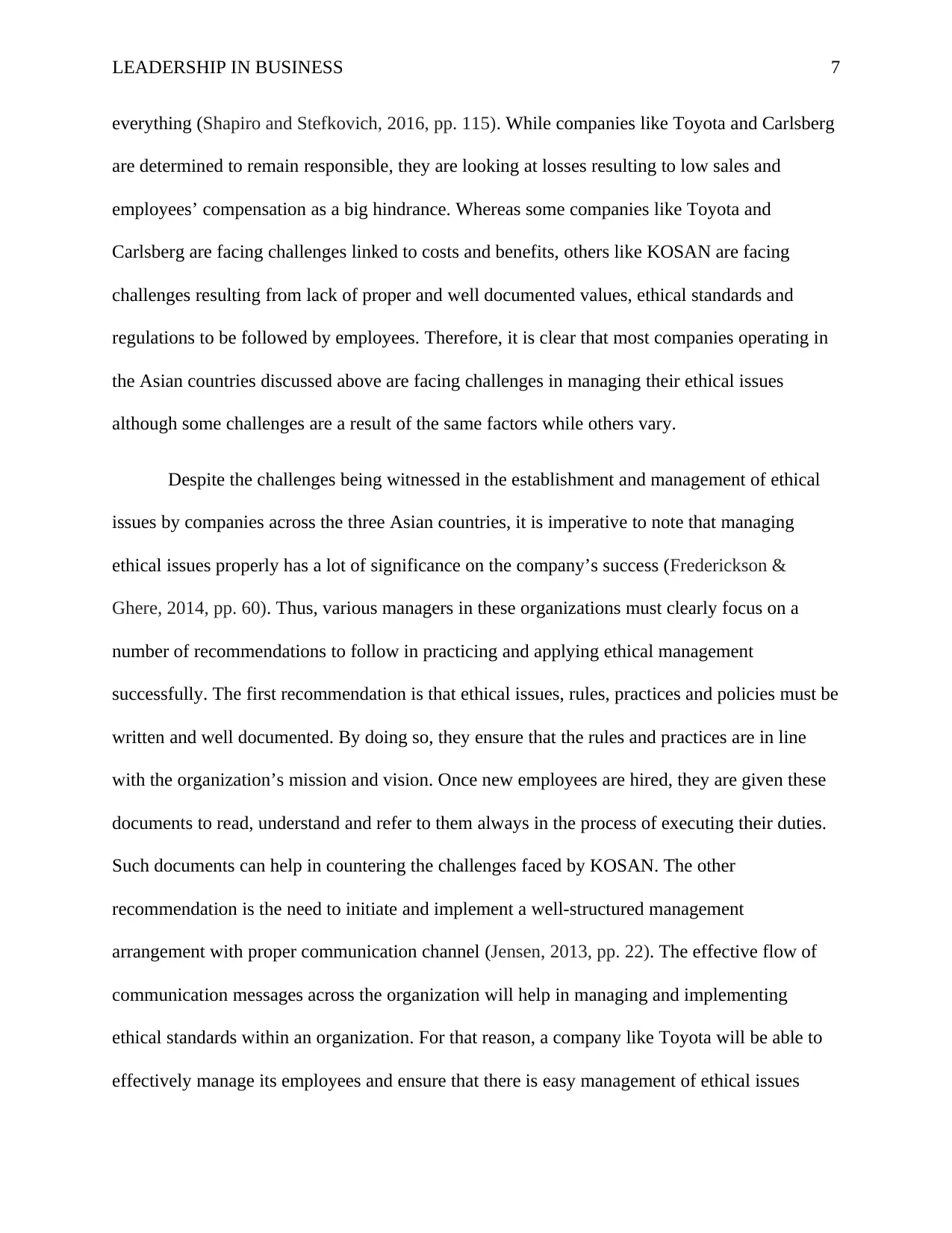
LEADERSHIP IN BUSINESS 7
everything (Shapiro and Stefkovich, 2016, pp. 115). While companies like Toyota and Carlsberg
are determined to remain responsible, they are looking at losses resulting to low sales and
employees’ compensation as a big hindrance. Whereas some companies like Toyota and
Carlsberg are facing challenges linked to costs and benefits, others like KOSAN are facing
challenges resulting from lack of proper and well documented values, ethical standards and
regulations to be followed by employees. Therefore, it is clear that most companies operating in
the Asian countries discussed above are facing challenges in managing their ethical issues
although some challenges are a result of the same factors while others vary.
Despite the challenges being witnessed in the establishment and management of ethical
issues by companies across the three Asian countries, it is imperative to note that managing
ethical issues properly has a lot of significance on the company’s success (Frederickson &
Ghere, 2014, pp. 60). Thus, various managers in these organizations must clearly focus on a
number of recommendations to follow in practicing and applying ethical management
successfully. The first recommendation is that ethical issues, rules, practices and policies must be
written and well documented. By doing so, they ensure that the rules and practices are in line
with the organization’s mission and vision. Once new employees are hired, they are given these
documents to read, understand and refer to them always in the process of executing their duties.
Such documents can help in countering the challenges faced by KOSAN. The other
recommendation is the need to initiate and implement a well-structured management
arrangement with proper communication channel (Jensen, 2013, pp. 22). The effective flow of
communication messages across the organization will help in managing and implementing
ethical standards within an organization. For that reason, a company like Toyota will be able to
effectively manage its employees and ensure that there is easy management of ethical issues
everything (Shapiro and Stefkovich, 2016, pp. 115). While companies like Toyota and Carlsberg
are determined to remain responsible, they are looking at losses resulting to low sales and
employees’ compensation as a big hindrance. Whereas some companies like Toyota and
Carlsberg are facing challenges linked to costs and benefits, others like KOSAN are facing
challenges resulting from lack of proper and well documented values, ethical standards and
regulations to be followed by employees. Therefore, it is clear that most companies operating in
the Asian countries discussed above are facing challenges in managing their ethical issues
although some challenges are a result of the same factors while others vary.
Despite the challenges being witnessed in the establishment and management of ethical
issues by companies across the three Asian countries, it is imperative to note that managing
ethical issues properly has a lot of significance on the company’s success (Frederickson &
Ghere, 2014, pp. 60). Thus, various managers in these organizations must clearly focus on a
number of recommendations to follow in practicing and applying ethical management
successfully. The first recommendation is that ethical issues, rules, practices and policies must be
written and well documented. By doing so, they ensure that the rules and practices are in line
with the organization’s mission and vision. Once new employees are hired, they are given these
documents to read, understand and refer to them always in the process of executing their duties.
Such documents can help in countering the challenges faced by KOSAN. The other
recommendation is the need to initiate and implement a well-structured management
arrangement with proper communication channel (Jensen, 2013, pp. 22). The effective flow of
communication messages across the organization will help in managing and implementing
ethical standards within an organization. For that reason, a company like Toyota will be able to
effectively manage its employees and ensure that there is easy management of ethical issues
Paraphrase This Document
Need a fresh take? Get an instant paraphrase of this document with our AI Paraphraser
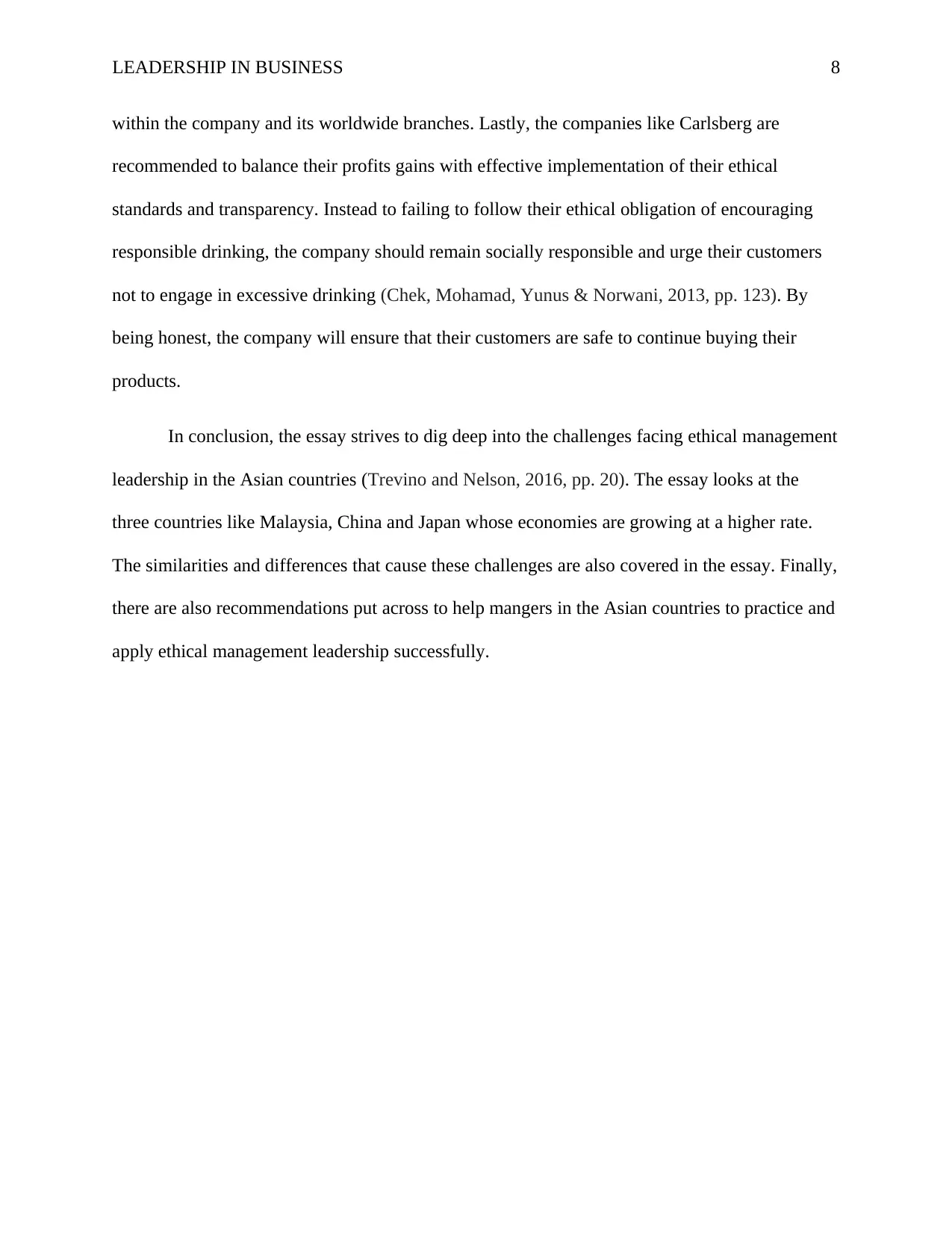
LEADERSHIP IN BUSINESS 8
within the company and its worldwide branches. Lastly, the companies like Carlsberg are
recommended to balance their profits gains with effective implementation of their ethical
standards and transparency. Instead to failing to follow their ethical obligation of encouraging
responsible drinking, the company should remain socially responsible and urge their customers
not to engage in excessive drinking (Chek, Mohamad, Yunus & Norwani, 2013, pp. 123). By
being honest, the company will ensure that their customers are safe to continue buying their
products.
In conclusion, the essay strives to dig deep into the challenges facing ethical management
leadership in the Asian countries (Trevino and Nelson, 2016, pp. 20). The essay looks at the
three countries like Malaysia, China and Japan whose economies are growing at a higher rate.
The similarities and differences that cause these challenges are also covered in the essay. Finally,
there are also recommendations put across to help mangers in the Asian countries to practice and
apply ethical management leadership successfully.
within the company and its worldwide branches. Lastly, the companies like Carlsberg are
recommended to balance their profits gains with effective implementation of their ethical
standards and transparency. Instead to failing to follow their ethical obligation of encouraging
responsible drinking, the company should remain socially responsible and urge their customers
not to engage in excessive drinking (Chek, Mohamad, Yunus & Norwani, 2013, pp. 123). By
being honest, the company will ensure that their customers are safe to continue buying their
products.
In conclusion, the essay strives to dig deep into the challenges facing ethical management
leadership in the Asian countries (Trevino and Nelson, 2016, pp. 20). The essay looks at the
three countries like Malaysia, China and Japan whose economies are growing at a higher rate.
The similarities and differences that cause these challenges are also covered in the essay. Finally,
there are also recommendations put across to help mangers in the Asian countries to practice and
apply ethical management leadership successfully.
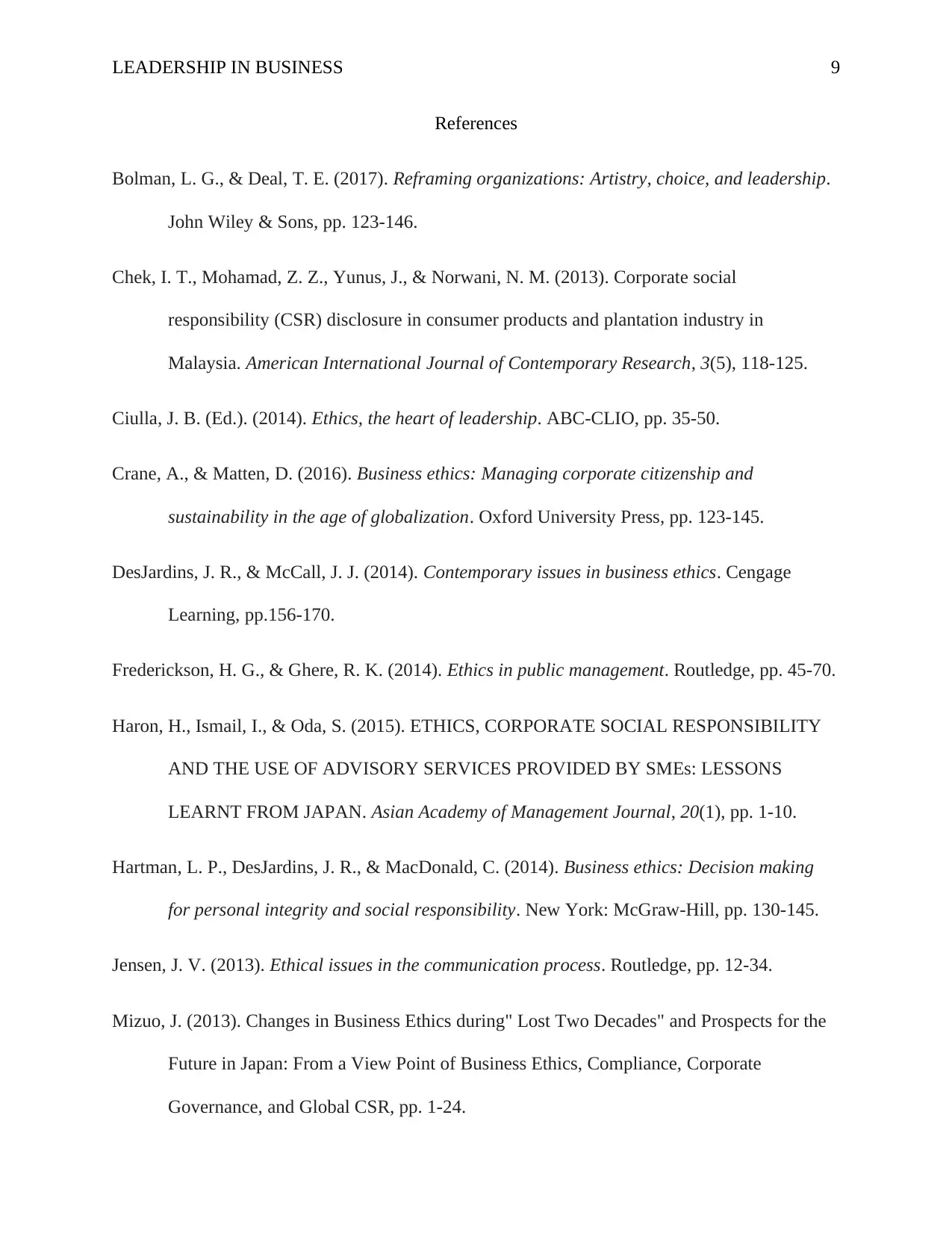
LEADERSHIP IN BUSINESS 9
References
Bolman, L. G., & Deal, T. E. (2017). Reframing organizations: Artistry, choice, and leadership.
John Wiley & Sons, pp. 123-146.
Chek, I. T., Mohamad, Z. Z., Yunus, J., & Norwani, N. M. (2013). Corporate social
responsibility (CSR) disclosure in consumer products and plantation industry in
Malaysia. American International Journal of Contemporary Research, 3(5), 118-125.
Ciulla, J. B. (Ed.). (2014). Ethics, the heart of leadership. ABC-CLIO, pp. 35-50.
Crane, A., & Matten, D. (2016). Business ethics: Managing corporate citizenship and
sustainability in the age of globalization. Oxford University Press, pp. 123-145.
DesJardins, J. R., & McCall, J. J. (2014). Contemporary issues in business ethics. Cengage
Learning, pp.156-170.
Frederickson, H. G., & Ghere, R. K. (2014). Ethics in public management. Routledge, pp. 45-70.
Haron, H., Ismail, I., & Oda, S. (2015). ETHICS, CORPORATE SOCIAL RESPONSIBILITY
AND THE USE OF ADVISORY SERVICES PROVIDED BY SMEs: LESSONS
LEARNT FROM JAPAN. Asian Academy of Management Journal, 20(1), pp. 1-10.
Hartman, L. P., DesJardins, J. R., & MacDonald, C. (2014). Business ethics: Decision making
for personal integrity and social responsibility. New York: McGraw-Hill, pp. 130-145.
Jensen, J. V. (2013). Ethical issues in the communication process. Routledge, pp. 12-34.
Mizuo, J. (2013). Changes in Business Ethics during" Lost Two Decades" and Prospects for the
Future in Japan: From a View Point of Business Ethics, Compliance, Corporate
Governance, and Global CSR, pp. 1-24.
References
Bolman, L. G., & Deal, T. E. (2017). Reframing organizations: Artistry, choice, and leadership.
John Wiley & Sons, pp. 123-146.
Chek, I. T., Mohamad, Z. Z., Yunus, J., & Norwani, N. M. (2013). Corporate social
responsibility (CSR) disclosure in consumer products and plantation industry in
Malaysia. American International Journal of Contemporary Research, 3(5), 118-125.
Ciulla, J. B. (Ed.). (2014). Ethics, the heart of leadership. ABC-CLIO, pp. 35-50.
Crane, A., & Matten, D. (2016). Business ethics: Managing corporate citizenship and
sustainability in the age of globalization. Oxford University Press, pp. 123-145.
DesJardins, J. R., & McCall, J. J. (2014). Contemporary issues in business ethics. Cengage
Learning, pp.156-170.
Frederickson, H. G., & Ghere, R. K. (2014). Ethics in public management. Routledge, pp. 45-70.
Haron, H., Ismail, I., & Oda, S. (2015). ETHICS, CORPORATE SOCIAL RESPONSIBILITY
AND THE USE OF ADVISORY SERVICES PROVIDED BY SMEs: LESSONS
LEARNT FROM JAPAN. Asian Academy of Management Journal, 20(1), pp. 1-10.
Hartman, L. P., DesJardins, J. R., & MacDonald, C. (2014). Business ethics: Decision making
for personal integrity and social responsibility. New York: McGraw-Hill, pp. 130-145.
Jensen, J. V. (2013). Ethical issues in the communication process. Routledge, pp. 12-34.
Mizuo, J. (2013). Changes in Business Ethics during" Lost Two Decades" and Prospects for the
Future in Japan: From a View Point of Business Ethics, Compliance, Corporate
Governance, and Global CSR, pp. 1-24.
⊘ This is a preview!⊘
Do you want full access?
Subscribe today to unlock all pages.

Trusted by 1+ million students worldwide
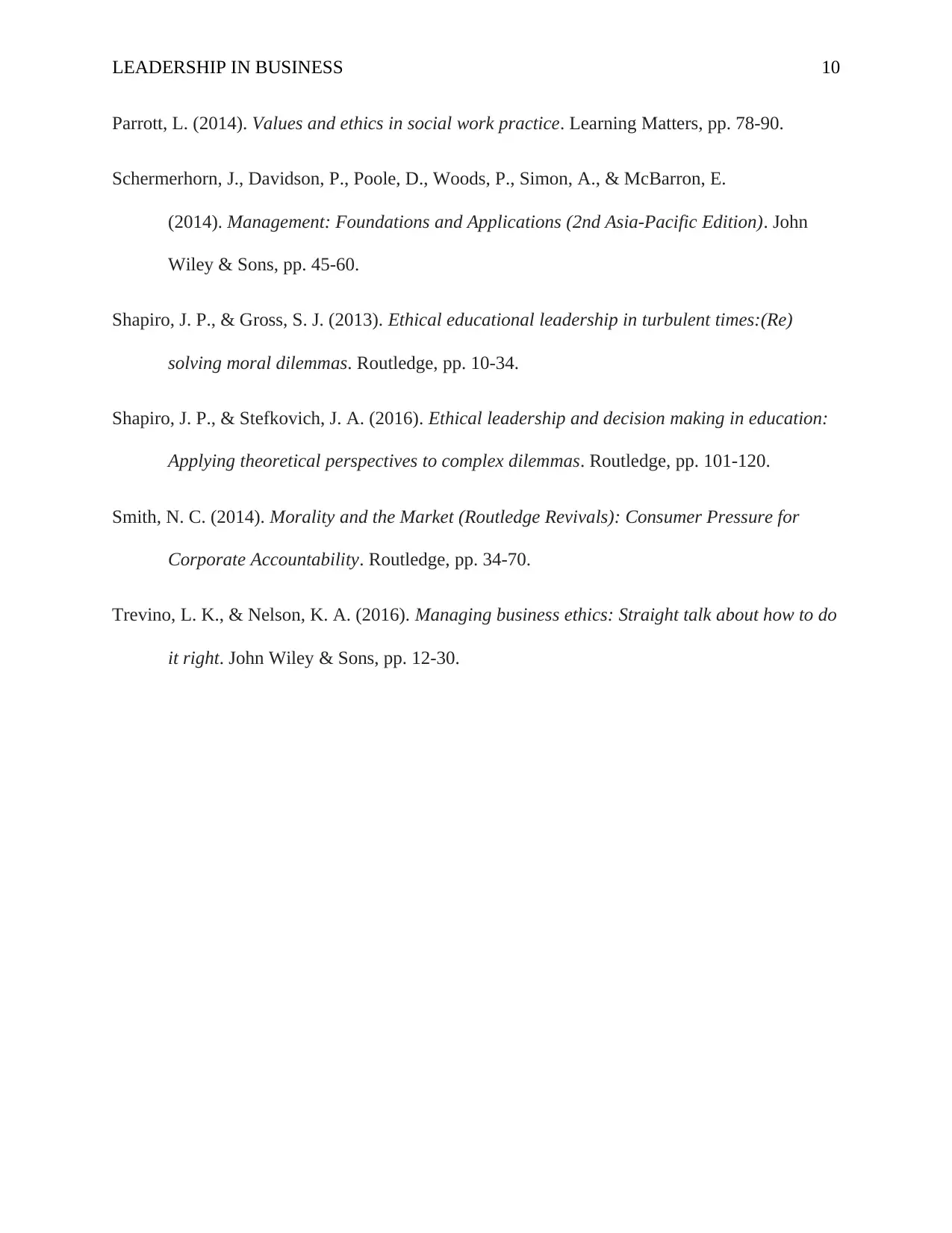
LEADERSHIP IN BUSINESS 10
Parrott, L. (2014). Values and ethics in social work practice. Learning Matters, pp. 78-90.
Schermerhorn, J., Davidson, P., Poole, D., Woods, P., Simon, A., & McBarron, E.
(2014). Management: Foundations and Applications (2nd Asia-Pacific Edition). John
Wiley & Sons, pp. 45-60.
Shapiro, J. P., & Gross, S. J. (2013). Ethical educational leadership in turbulent times:(Re)
solving moral dilemmas. Routledge, pp. 10-34.
Shapiro, J. P., & Stefkovich, J. A. (2016). Ethical leadership and decision making in education:
Applying theoretical perspectives to complex dilemmas. Routledge, pp. 101-120.
Smith, N. C. (2014). Morality and the Market (Routledge Revivals): Consumer Pressure for
Corporate Accountability. Routledge, pp. 34-70.
Trevino, L. K., & Nelson, K. A. (2016). Managing business ethics: Straight talk about how to do
it right. John Wiley & Sons, pp. 12-30.
Parrott, L. (2014). Values and ethics in social work practice. Learning Matters, pp. 78-90.
Schermerhorn, J., Davidson, P., Poole, D., Woods, P., Simon, A., & McBarron, E.
(2014). Management: Foundations and Applications (2nd Asia-Pacific Edition). John
Wiley & Sons, pp. 45-60.
Shapiro, J. P., & Gross, S. J. (2013). Ethical educational leadership in turbulent times:(Re)
solving moral dilemmas. Routledge, pp. 10-34.
Shapiro, J. P., & Stefkovich, J. A. (2016). Ethical leadership and decision making in education:
Applying theoretical perspectives to complex dilemmas. Routledge, pp. 101-120.
Smith, N. C. (2014). Morality and the Market (Routledge Revivals): Consumer Pressure for
Corporate Accountability. Routledge, pp. 34-70.
Trevino, L. K., & Nelson, K. A. (2016). Managing business ethics: Straight talk about how to do
it right. John Wiley & Sons, pp. 12-30.
1 out of 10
Related Documents
Your All-in-One AI-Powered Toolkit for Academic Success.
+13062052269
info@desklib.com
Available 24*7 on WhatsApp / Email
![[object Object]](/_next/static/media/star-bottom.7253800d.svg)
Unlock your academic potential
Copyright © 2020–2025 A2Z Services. All Rights Reserved. Developed and managed by ZUCOL.




